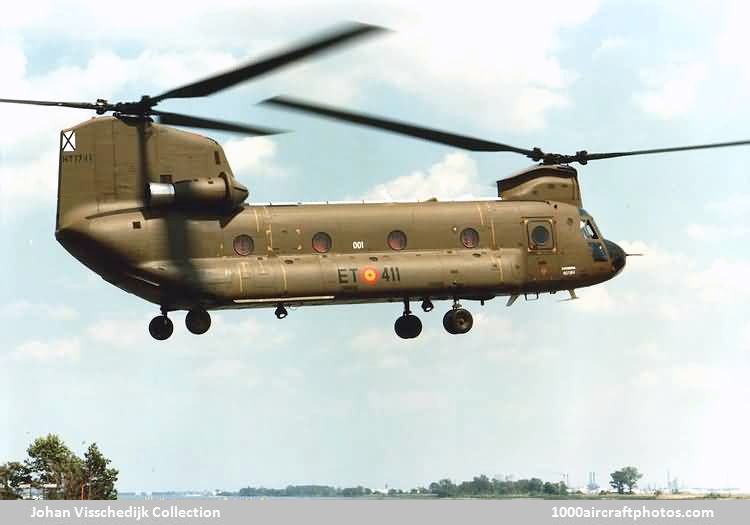First production Model 414 in Spanish Army markings, during a test flight at Boeing Vertol's suburban Philadelphia, PA., manufacturing head-quarters. The Model 414, which is Boeing Vertol's newest international military Chinook, is considered the most advanced medium lift helicopter now available. It contains the following features:
• Avco-Lycoming T55-L-712 engines
• composite rotor blades
• single-point pressure refueling
• triple cargo hook system, with the center cargo hook rated at 28,000 lb (12,701 kg)
• 40 KVA generators
• advanced flight control system
• and, an improved avionics package
Boeing Vertol Press Information, released at the 1983 Paris Air Show:
PHILADELPHIA, PA, MAY 26, 1983--The operational capability and mission flexibility of the Spanish Army has been greatly enhanced through the successful service introduction by the Fuerzas Aeromobiles Ejercito de Tierra (FAMET), (Army's Air Mobile Forces), of the three new Boeing Vertol-built Model 414 Chinook helicopters.
Since their arrival in late 1982, the newest additions to the Spanish Army's all-Chinook battalion, BHELTRA-V (Battalion Helicopter Transport Five) have already proven their merit in several demanding situations.
As the only helicopters in the Spanish inventory equipped with triple external cargo hooks and capable of lifting payloads as large as 14 tons, the Model 414 Chinooks were quickly pressed into service by the FAMET to:
• provide large payloads of relief supplies -- food, water, medicine, hospital tents, etc. -- and evacuate people stranded
• in flood-stricken Valencia when storms ravaged that town in mid-October, 1982;
• transport, by external cargo hooks, 32 ft long by 20 ft wide (9.75 by 6.10 m) rubber and metal pontoons essential
• for use as temporary bridges;
• and, carry heavy equipment and key support personnel involved with the recent visit to Spain of Pope John Paul II.
"The Spanish Army Chinook pilots show a high degree of enthusiasm for many of the improved systems on their new Boeing 414s," said Ron Mecklin, a Boeing Vertol test pilot, who has spent several weeks in Spain assisting FAMET Chinook pilots with the Model 414's introduction into service.
Mecklin praised the skills of the Spanish Chinook pilots and said that the men of the FAMET were especially pleased with the 414's triple cargo hook system, as well as its automatic flight control system, composite rotor blades, Avco-Lycoming T55-L-712 engines, and the aircraft's handling characteristics.
Although the Chinook 414s have been a part of the inventory for only a few months, the FAMET has been operating Chinooks since 1973. The addition of the three Model 414s increases BHELTRA-V's fleet to twelve Chinooks.
Since operations began in 1973 the FAMET's Chinooks have been used for a variety of civil and military missions for which they are uniquely qualified, some of which include: lifting damaged Spanish Air Force F-4C jet fighters from their operational base to a repair facility; installing roof top air conditioning systems on manufacturing plants; and, emplacing ski lift pylons in the Pyrenees Mountains.
Missions more typically performed by BHELTRA-V include: Army logistical support, paratroop support, disaster relief, search and rescue assistance, and VIP transport. BHELTRA-V is based at Colmenjar, Viejo, Spain.
The initial Spanish Army Chinook order was in 1972, with a follow-on order for three additional aircraft in 1975.
The Model 414 Chinook is the international military version of the famed Boeing Chinook and is the most advanced medium-lift helicopter now available. The Model 414 contains the following features:
• composite rotor blades;
• single-point pressure refueling;
• Avco-Lycoming T55-L-712 engines;
• triple cargo hook system, with the center cargo hook rated at 28,000 lb (12,701 kg);
• 40 KVA generators;
• advanced flight control system;
• and, advanced avionics.
